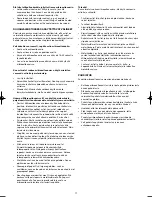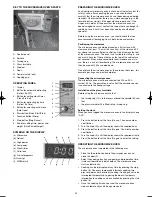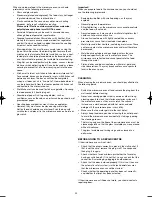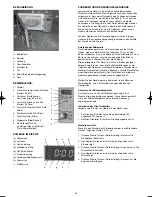
When you prepare food in the microwave oven, you should
preferably use the following implements:
•
Glass and glass bowls
•
Stoneware (glazed and unglazed). The food stays hot longer
in glazed stoneware than in other dishes.
•
Plastic containers These can be used for many heating
purposes, but are not suitable for roasting.
Please note! Plastic containers made from melamine,
polyethylene and phenol must NOT be used.
•
Porcelain All porcelain can be used in microwave ovens,
although fireproof porcelain is preferable.
•
Fireproof covered dishes Glass dishes with lids that fit so
closely that steam cannot escape are ideal for vegetables
and fruit to which no liquid is added (however, the cooking
time must not exceed 5 minutes).
•
Browning dishes You must be very careful when using this
type of dish. Never heat the browning dish for more than 5
minutes on the turntable. Suitable insulation, such as a heat-
tested plate, should be placed between the browning dish
and the turntable to prevent the turntable from overheating.
•
Clingfilm can be used particularly for soups, sauces, stewed
dishes or when defrosting food. Can also be used as a loose
covering to prevent fat, etc. from spraying out into the oven
space.
•
Kitchen roll is ideal, as kitchen roll absorbs moisture and fat.
For example, bacon can be placed in layers, with kitchen roll
between each layer. The bacon will then be completely
crispy, as it does not sit in "its own fat". Home-baked bread
can be taken directly from the freezer, packed in kitchen roll
and heated in the microwave oven.
•
Wet kitchen roll can be used for fish or vegetables. Covering
the food prevents it from drying out.
•
Greaseproof paper Fish, large vegetables, such as
cauliflower, corn on the cob and similar can be packed in wet
greaseproof paper.
•
Roasting bags are ideal for meat, fish and vegetables.
However, they must never be closed using metal clips.
Cotton thread should be used instead. Prick the bag with
small holes, and place it in the microwave oven on a plate or
glass dish.
Important!
When you prepare food in the microwave oven, you should not
use the following implements:
•
Sealed glass/bottles with small openings, as they may
explode.
•
General purpose thermometers
•
Silver foil/foil trays, as the microwave rays cannot penetrate
and the food will not cook.
•
Recycled paper, as it may contain small metal splinters that
could cause sparks and/or a fire.
•
Closed tins/containers with tightly sealed lids, as excess
pressure may cause the tin/container to explode.
•
Metal clips and other lids/foils, containing metal wires. These
can form sparks in the microwave oven and must therefore
be removed.
•
Metal bowls/containers and packaging, unless they are
designed specifically for use in microwave ovens. The
microwaves are reflected and cannot penetrate the food
through the metal.
•
Plates, dishes and bowls/containers with metal, gold and
silver decorations. They may break and/or cause sparks to
form in the oven space.
CLEANING
When cleaning the microwave oven, you should pay attention to
the following points:
•
Switch the microwave oven off and remove the plug from the
wall socket before cleaning.
•
Never use scouring powder, steel scourers or other strong
cleaning agents to clean the interior or exterior surfaces of
the microwave oven, as they may scratch the surfaces.
•
Instead use a cloth dampened with hot water, and add
detergent if the microwave oven is very dirty.
•
Make sure that no water gets into the vent holes.
•
Always keep the door open when cleaning the control panel,
to avoid the microwave oven accidentally starting up during
the cleaning process.
•
The turning ring and the floor of the microwave oven must be
cleaned regularly so that the glass turntable can move around
without hindrance.
•
The glass turntable and turning ring can be cleaned in a
dishwasher.
BEFORE GOING TO A REPAIR CENTRE
If the microwave oven will not start:
•
Check that the plug is correctly in place in the wall socket. If
that is not the case, remove the plug, wait 10 seconds and
then plug it in again.
•
Check whether a fuse has blown or whether the fuse relay
has been switched off. If it is not that, you can check that the
socket itself is working by plugging in another device.
•
Check that the door is closed properly. If this is not the case,
the automatic safety system (via the lock dowels) ensures
that the microwave oven cannot be started.
•
Check whether the operating panel has been set correctly,
and whether the timer has been activated.
If the microwave oven still does not work, you should contact a
repair engineer.
23
753094_IM
04/07/05
13:00
Side 23














































